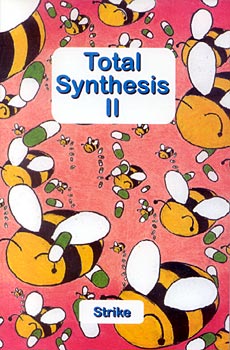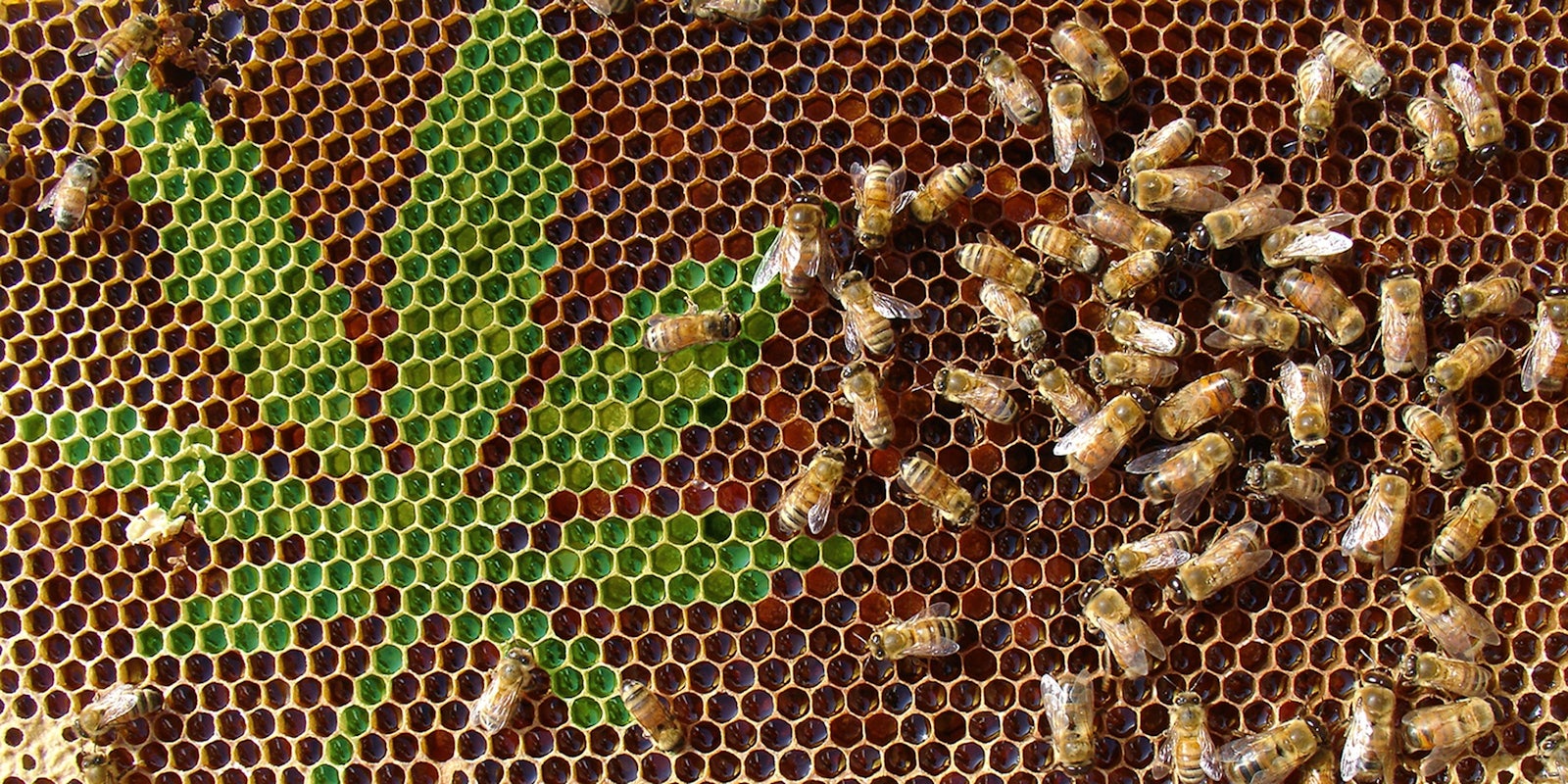If you wanted to make ecstasy at home in the late 1990s, Strike was your man. He ran what was easily biggest online community dedicated to clandestine chemistry—the art of making illegal drugs—and had written three successful books detailing every step needed to produce high-quality MDMA, the drug’s active ingredient.
Chemicals weren’t a problem, either. The Texas supply shop Strike owned, and which brought him $450,000 a year, fed goods directly to the eager customers in his community. At a time when the Internet was a fraction of its current size, police seemed either clueless or uninterested.
Strike was the Internet’s professorial drug kingpin, loved by his followers and described as a “cult hero” by critics. Then in 2001, an NBC Dateline investigation ripped off Strike’s mask and it all came crashing down. With Strike—actually 33-year-old Hobart Huson, as Dateline revealed—in the national spotlight, police finally wizened up. He served eight years in jail.
Drug marketplaces have undergone a renaissance in recent years thanks to the anonymizing power of Tor software, which lets buyers and sellers connect on an encrypted region of the Internet known as the Dark Web. But Strike was neither the first nor the last of his kind. The history of the Internet’s complicated relationship with drugs began more than 15 years earlier, in the buzzing forums of the World Wide Web’s enduring ancestor.
Birth of a digital drug culture
In his 1997 Wired essay “Birth of a Digital Nation,” Jon Katz described a new culture spawned from the Internet’s “primordial digital muck.” It would touch every facet of our lives, Katz mused, changing everything from economics and politics to freedom and the evolution of ideas.
“I couldn’t bear The New York Times pundits, CNN’s politico-sports talk, the whoring Washington talk shows, the network stand-ups,” he wrote, referring specifically to shows like CNN’s Crossfire. “Why attend to those tired institutions when what was happening on the monitor a foot from my nose seemed so much more interesting?”
Katz saw a common thread in the new digital culture: a distinct strain of non-partisan libertarianism. In particular, he noted how that strain was applied to recreational drugs, such as pot and ecstasy.
 The Internet’s ingrained disdain for the war on drugs and its affinity for some big libertarian ideas manifested in the birth and blossoming of an online drug culture. The digital highway (described in 1997 by Katz as the way information traveled down linked “Web sites, passed on to newsgroups, mailing lists, and computer conferencing systems”) provided an ideal new environment in which the trade could grow freely.
The Internet’s ingrained disdain for the war on drugs and its affinity for some big libertarian ideas manifested in the birth and blossoming of an online drug culture. The digital highway (described in 1997 by Katz as the way information traveled down linked “Web sites, passed on to newsgroups, mailing lists, and computer conferencing systems”) provided an ideal new environment in which the trade could grow freely.
For those who have grown up on the Web, it’s easy to forget the scale of change that Katz (born in 1947) and others felt when looking to the Internet’s future. At the fevered height of the war on drugs, early Internet users wondered what kind of change to the status quo could one realistically hope for from the emerging technology.
As he watched a wave of unknowable size approach, Jay Katz was hoping for a tsunami.
Usenet and alt.drugs
Long before that essay, Katz’s “primordial digital muck” had begun mixing together on Usenet. The network, established in 1979, ran newsgroups organized into eight major groups known as hierarchies: comp, humanities, misc, news, rec, sci, soc, and talk. It was the precursor to Internet forums as we know them today.
Over time, Usenet’s administrators, known as the backbone cabal, had earned a reputation for heavy-handedness. They refused, for example, to allow groups focusing on taboo subjects, such as sex or drugs. While other newsgroups existed outside of the big eight, covering subjects from The Simpsons to the occult, none attracted the same audience, meaning that anyone who wanted to talk about topics outside the mainstream was relegated to a newsgroup ghetto.
In 1987, programmer and civil libertarian activist John Gilmore and computer scientist Brian Reid created the “alt” newsgroup as an alternative to the big eight. Gilmore, who later cofounded the Electronic Frontier Foundation, launched the project after the cabal forbade him from creating a discussion group focused on drugs. Brian met similar refusals when attempting to create a group discussing sex. Some time after the creation of alt.*, Brian Reid sent this now-famous email to the cabal:
To end the suspense, I have just created alt.sex. That meant that the alt network now carried alt.sex and alt.drugs. It was therefore artistically necessary to create alt.rock-n-roll, which I have also done. I have no idea what sort of traffic it will carry. If the bizzarroids take it over I will rmgroup it or moderate it; otherwise I will let it be.
Brian Reid
Alt became popular immediately thanks to freewheeling discussion in alt.sex, and soon thereafter, alt.drugs became one of the most active groups. Reflecting the level of demand, the first question in the group’s FAQ was about how to buy illegal drugs.
“Don’t,” came the answer. “The network is scanned by authorities.”
While outright buying and selling was never the norm on alt.drugs, sales happened in private, facilitated by the newsgroup. The groups of alt.drug. became the focal point of online drug culture well into the 1990s, even as Usenet declined thanks to the rise of the World Wide Web.
Alt.drugs never became an outright marketplace. However, the group did openly and prolifically produce what would become one of the most controversial aspects of online drug culture: detailed manufacturing guides, known as cookbooks.
Some of the most prized posts provided instruction on how to make MDMA, how to grow marijuana (many of which are still available online), and how to produce a long list of other drugs ranging from popular to obscure. The guides were and are legally protected free speech in the United States, placing them outside of the reach of the legal and moral authorities.
“The secret language of symbols”
Alt.drugs.chemistry became the centers of drug knowledge and clandestine chemistry on the Web, as well as the foundation from which online drug culture grew.
One of its members was Jeffrey Jenkins, a Florida man who the Internet knew only as Eleusis. The pseudonym referred to a town in Ancient Greece, whose famous religious festivals involved mind-altering substances and the honey from local bees, considered a divine insect revered in myth and ritual. Jenkins’s allusion to bees is the first in what has become a long tradition of references and reverence to the buzzing bugs in online drug culture.
Jenkins found alt.drugs.chemistry in 1994. From there, he dove into the science. A portion of his work is still available today.
“Organic chemistry intrigued me,” he wrote in his memoir.
“It tempted me with its secret language of symbols, its demand for (nearly) blind faith in unseen collisions. MDMA intrigued me as well, with its strangely universal experience, its ability to make even the hardest soul empathic. I had tried neither organic chemistry nor MDMA, so I decided to try both.”
Jenkins became a prolific poster in the group, sharing his knowledge and experience while looking down upon those who used that information “for purely economic reasons.”
“You can see my struggling in practically every post I made,” he wrote, “the schizophrenic vacillations in tone between erudite dissertation and egomaniacal evisceration. Though I knew my posts would be put to use by those less scrupulous, I posted nonetheless for the benefit of those who were.
“I broke every rule in the book, and I did so knowingly.”
Jenkins ordered glassware and chemicals with his real name and credit card, shipping to his parents and co-conspirator’s houses. He spent hundreds of hours doing research in the library and then conducted experiments in his apartment. To his surprise, he was not busted.
“I did all of this in blind faith because the first time I took MDMA was my own.”
Jenkins’s story becomes more complicated after that. After a trip to Texas to buy chemicals for production (or, as he sarcastically put it, “a bunch of fairly innocuous chemicals”), the shipping hit a snag and the chemicals never made it to his home. Convinced they’d be confiscated by the police, Jenkins publicly quit alt.drugs.chemistry, packed up his lab and anxiously awaited the arrival of the police.
Months passed but no sirens sounded.
Jenkins’s lab started again. He produced large batches of psychedelic drugs, all of which were designated Schedule I controlled substances by the United States government.
That’s when the Drug Enforcement Administration (DEA) called. They had raided his parents’ home. After questioning him about the missing package and an ex-girlfriend of his now in custody, it was clear he’d been busted.
“Consent was then asked for to search my apartment, under the threat that I would be arrested if I said no and they would get a warrant anyway,” wrote Jenkins. “I knew this would happen because of what POP-I [a prominent alt.drugs user] had told me so I signed my life away. Agents were standing by at my apartment and busted in the door as soon as my pen hit the paper.”
Jenkins was handcuffed, taken to his apartment to identify the contents, and then transported to DEA holding.
“Apparently seconds after I was taken away the reporters arrived. My driver’s license picture was on the 6:00 news. The entire block I lived on was evacuated. Rumors started flying and all of my friends, of which only a very few knew what I did, started calling each other.”
The DEA agent assigned to the case said it was “the most technologically advanced lab I have ever seen.”
“We’ve never seized a lab like this before,” Sergeant Jose Penichet said, according to the Tampa Tribune, the lab was capable of producing “up to 2 ounces of methamphetamine or ecstasy a week,” “enough ecstasy to supply Southern Florida.”
Hidden toward the end of Jenkins’s memoir, which he wrote mainly from jail, was the paragraph many alt.drugs.chemistry users were most curious about:
“It is rather apparent from my interrogation and the investigation thus far that the DEA either *does not know about a.d.c.* or they *do not care*. Yes, friends, hard as it may be to believe, outside of the ‘did you get the recipe off the internet’ question, they didn’t ask me jack shit about the net.”
Jenkins was sentenced to six years in federal prison in 1998. He was released in 2002.
Bees at the Hive
The growing list of guides and FAQs put together by the alt.drug population amounted to a significant knowledge base of immense value to chemists looking to cut out the middlemen and produce drugs with cutting-edge techniques.
That knowledge base would span generations. As alt.drugs and all of Usenet declined in the mid-1990s, the online drug community moved on towards standalone websites and forums. This marked the beginning of a fracturing in the online drug community that continued for over a decade, reversed only recently to a significant extent by the unprecedented rise of Silk Road.
In 1997, one of the most significant heirs to the alt.drugs community came into existence: the-hive.ws.
The purpose of the Hive was to provide a place in which the “bees,” or users, could discuss home chemistry. From the topic at hand to the specific users discussing it, the Hive was a direct descendant of the alt.drugs.chemistry newsgroup.
The Hive was dedicated to the “hypothetical” synthesis of chemicals to produce mind-altering drugs. Just as “hypothetical” was a joke directed toward law enforcement, the acronym SWIM (Someone Who Isn’t Me) was born on the site to throw authorities off.
The Hive was founded in 1997 by an anonymous user named Strike. Strike authored three of the first MDMA cookbooks ever published: Total Synthesis 1 and 2, and Sources. Strike himself described Total Synthesis 2 as “the most comprehensive and detailed book on the underground production of ecstasy and amphetamines ever published.” 
Whereas the Total Synthesis books were top-of-the-line drug cookbooks, Sources was a comprehensive list of “nearly every place in the world that sells chemicals, equipment, glassware, essential oils, and aromatic chemicals.” Everything in the book was personally scrutinized by Strike. The author promised customers that Sources would provide home chemists with the materials they needed to create their drug of choice. Strike’s favorite choice by far was MDMA, “the most benign drug [I have] ever encountered.”
The books retailed for around $30 on release. Today, they can sell for much more.
As the Hive and Strike’s fame grew, he became a “cult hero” in the drug community, a man whose online “swagger” was “like a pirate on the high seas,” as Dateline‘s John Larson put it. Strike was fond of referring to himself in the third person, projecting a persona of supreme, over-the-top self-confidence. According to the Hive’s own “about page” in 1999, he was “an ecstasy and amphetamine chemist from Texas that used to be very frustrated by the lack of basic chemical information about ecstasy, and other psychedelic amphetamines.”
Strike provided day-to-day guidance for fellow chemists on subjects such as where to buy equipment and specific recipes for kitchen chemists of every stripe. For most chemists, this was a difficult task. Chemical companies are obligated by law to check into customers who were buying the sort of chemicals that Hive users purchased. To skirt potentially dangerous questions, Strike pointed most bees toward Science Alliance, a Humble, Texas-based chemical company that, he said, would sell the goods with no strings attached.
By early 2000, after three years at the helm, Strike ostensibly retired from the Hive. In February 2000, he let the forum know that he’d been involved in “above-board assaults on the drug war,” such as the November Coalition, an advocacy group dedicated to ending mandatory minimum sentencing laws that made even small drug busts result in serious jail time.
Though he’d semi-officially retired, Strike and the Hive soon entered the national limelight. In 2001, NBC aired the results of a 10-month-long investigation into the site and its users. It began when the news magazine obtained tapes of a group of college students documenting hours of ecstasy use, partying, and most damning of all, illegally purchasing industrial-strength lab equipment, with which they began wide-scale production of the drug.
Below, we’ve posted the full Dateline investigation. The audio on the first clip is buggy, but the others are fine.
Operation Triple X
Dateline revealed Strike to be Hobart Huson, the man directing Hive users to buy his books, equipment, and “precursor chemicals” from his own company, which he ran with a partner, Darren Harlow. Strike, the revered chemist and underground icon, turned out to be a poor liar forced to come to terms with being caught red-handed while the cameras rolled and the melodramatic music played.
Strike’s choices on that day shocked the Dateline audience, which included both Hive members and its general viewership. Why would Huson agree to an interview with NBC? When asked about Strike sending customers his way, why would he say something like “I’m going to beat him up if I find him?” Why would he have a bee-stuffed animal sitting on top of his computer monitor while NBC peppered him with questions about the Hive?
“I think Strike was a tiny bit arrogant, a tiny bit willing to show off what he was part of and what he’d done,” wrote Von Bass. “To be honest, I sympathise with him, to a person with his mind set creating and organising the hive and undertaking various synthetics where really something to be proud of. That doesn’t mean he wasn’t tricked and taken advantage of by the reporters.”
Science Alliance grossed $450,000 in 2000 with a profit of over $100,000, according to court documents. Huson and Harlow both took home $50,000 salaries (which, Hobart insisted, “I paid taxes on!”). Huson invested the rest of the balance back into the business. In 2001, the pair were expecting $60,000 salaries. Huson told the police that he shipped about 15 orders of chemicals and equipment per day on average. His trio of books grossed about $15,000 per year, money that he said helped him and his family live.
Three Hive users were featured in Dateline’s investigation. The students filmed themselves purchasing flasks and safrole for $2000 from a Hive user named Spitball. He was arrested in 2000 for MDMA and meth manufacturing, according to another former Hive member.
 Strike, of course, played the starring role, for which he earned an eight-year jail sentence.
Strike, of course, played the starring role, for which he earned an eight-year jail sentence.
The college students busted on Dateline weren’t the only ones caught producing illegal drugs with Huson’s help. In what was known as “Operation Triple X,” the FBI busted a 20-person ecstasy ring in Escondido, Calif. in October 2001 that had purchased many of their chemicals from Huson. After his products were, according to police, also found in illegal drug labs from Oregon to Atlanta, he was convicted in 2003 and remained incarcerated until June 2009.
When interviewed by the police in May 2001, Huson criticized what he saw as harsh drug laws, acknowledging his activism and proselytizing against the war on drugs. When the police asked Huson about users who had slipped into comas as a result of his products, Huson said only that, as far as he knew, the people had recovered. A detective asked Huson if it bothered him that his books were being used to teach the manufacturing of ecstasy.
“No! If you tried ecstasy then you’d know why I did what I did!”
The new chemist in town
Despite his fame, Strike was not the be-all, end-all of the Hive. It was a community of highly capable chemists—trailblazers intent on gaining and sharing knowledge online. Strike was the founder and face, but the site continued to grow to thousands of users without him. After Strike left the Hive, a user named Rhodium and other administrators who made the website what it was at its peak.
Much of Rhodium’s vast archives remain available today on sites such as Erowid and Drugs-Forum.com. His or her identity remains a mystery. In an interview with police, Huson said he thought Rhodium was “a very good chemist from a foreign country,” he thought Sweden. Thomas Lillius, former owner of a Swedish chemicals company and accused by the DEA of instructing several alleged chemists caught by Operation Triple X, is one much-discussed candidate for the man behind Rhodium, a figure still revered today. Lillius was not arrested in Operation Triple X due to extradition laws. He remains at large today.
Then there’s Jenkins, a.k.a., Eleusis, the mastermind behind those legendary alt.drugs cookbooks. Some Hive users theorized that Jenkins may have played an important role in the site’s founding. Remember that Jenkins had taken his online handle from an ancient festival centered around bees. Many of alt.drugs.chemistry’s users moved directly to the Hive after Usenet began to decline, and it stands to reason Jenkins could have been one of them.
He was certainly well-regarded throughout the Hive community. The site itself prominently linked to his memoirs from its front page in 1998 (the year he was sent to prison), underneath which sat this postscript: “There is a new chemist in town (or is it an old one?). The Hive proudly welcomes a new ally to the site. Click on the above link to go the site of a chemist who’s [sic] knowledge far exceeds our own!”
Then there’s the fact that Jenkins’s memoir recounts an important trip he took to Texas to purchase production chemicals in 1994. Don’t forget that Huson, the Hive’s founder, ran his chemical warehouse out of Humble, Texas.
The path to Silk Road
The Hive finally disappeared due to unspecified “server problems” in 2004. While material from users such as Rhodium remain publicly available online, the forum’s complete archives are mostly gone. For a while, a site called TorDrugResource, contained incomplete but significant archives of the Hive’s forums. Then that site’s host, Freedom Hosting, was destroyed in early August as part of what is likely a raid from the FBI or another U.S. law enforcement agency.
There are rumors that the site’s complete knowledge base still exists, however, locked up from the outside world by some of the site’s old administrators.
When the Hive collapsed, online drug culture fractured further into a multitude of then-smaller sites, which attracted most of the old bees. But a code of silence kept most of the old active users quiet.
“The less associated you were with all that the better,” wrote Doctor War, a one-time Hive regular. “Shit went down and those who wanted to stay free and uninvestigated, did so. And they usually try not to mention the good/bad old days except in private to those who were there with them.”
In 2009, the Vespiary forum—named after a nest of wasps—was launched. The website is a careful heir to the Hive. Users cannot outright sell drugs or manufacturing supplies or link to sellers on the forum, and it bans personally identifying information. Administrators seek to keep crime and an old reputation at arm’s length.
Though it treads relatively lightly, the Vespiary is an heir nonetheless. Detailed guides to manufacturing and manipulating psychedelics remain the site’s bread and butter. Discussions about ordering prohibited chemicals from major companies and dumpster diving at university chemistry departments are two of hundreds of discussions about acquiring the required goods.
The Hive’s influence on the world is undeniable. Online drug culture has been shaped by bees. Even Breaking Bad, the much-loved drug drama on AMC, referenced the Hive in a 2011 episode when a bee logo was on a barrel of methylamine used to synthesize methamphetamine.
The most significant reversal of fortune for online drug marketplaces has been the Silk Road. Since 2011, it’s been the online capital of sales and discussion for a range of drugs much wider and more diverse than anything preceding it.
It’s origins, however, lay firmly in the techno-libertarian origins of the Web, in Katz’s digital muck.
Illustration by Jason Reed


